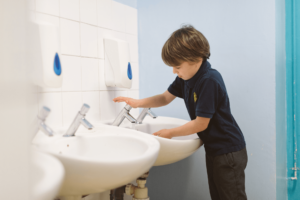Who isn’t fascinated by the history of the toilet? The subject of toilets is something that appeals to everyone’s inner five-year-old even though we’re not supposed to mention it in polite company!
Unfortunately, very little historical information is recorded on the subject, considering it serves a vital function for everyone, we have very little to go on. A quick online search reveals that Terry Deary’s Horrible Histories books and the accompanying TV series appear to be the only historical sources where toilets are actively celebrated – naturally enough, they’re aimed at children!
There’s even less information recorded about the office loo, although the 17th century diarist Samuel Pepys makes a reference to a toilet as a ‘house of office’ which seems quite fitting. There is also evidence that Martin Luther, the 16th century religious reformer whose theological works inspired the Reformation, had a toilet integrated into his office where he held meetings.
Going potty
Chamber pots have been used throughout history as a convenient way of going to the loo without having to go outside. Using a chamber pot meant people didn’t have to ask the carriage driver to stop on long coach journeys and offered a way of getting through long sermons without incurring the disapproval of the preacher by having to leave. We can only assume that they would also have been used in workplaces.
The Industrial Revolution changed toilet practices, with many workers’ cottages being built with shared or separate outside toilets, known as ‘earth closets’ and nicknamed ‘outhouses’ or ‘privies’. These worked in a similar way to today’s compostable toilets, and they were emptied manually by ‘night men’ who, as the name implies, did the job at night.
Flushed with success
The widespread use of flush toilets didn’t happen until the late 19th and early 20th century. The first pay toilets were introduced at the Great Exhibition in 1851 – members of the public had to spend a penny for the privilege, which is where the popular saying comes from. Public toilets began to spring up in London, but they were only for gentlemen – it was thought to be so unseemly for a Victorian lady to use one that no women’s toilets were built, effectively meaning that women couldn’t venture far from their homes in case they got caught short. This was also the case in the workplace, which meant that many women were excluded from working because of the lack of suitable conveniences.
Retailers came to women’s rescue at the end of the 19th century when shop owners in London’s West End realised that the longer women were out, the more money they’d spend. So, the first public convenience for women opened in Piccadilly Circus in 1889, which prompted more ladies’ loos to become available across the country, giving women much greater freedom of movement.
Office toilet history in the late 20th century
With so little documented information available about office loo history, we must revert to anecdotal evidence. Ask an older person about the ‘joys’ of having to use outside toilets in their workplaces, and you’ll get a lot of stories about running through the rain to use cold, dank, spider-filled toilets where you definitely wouldn’t want to stick around for a gossip!
You may get a glimpse of how things were in contemporary films and television programmes – although it wasn’t until the 1960 film Psycho that censors even allowed a toilet to be seen on screen. Most appearances of toilets in 20th-century movies tended to be for shock or comedy value. There are very few workplace toilets making appearances at all, with the notable exception in the ‘80s cop show Cagney & Lacey where the two women protagonists spent time in their police station’s ladies room in virtually every episode.
Possibly the best use of office toilets in a movie is designed mainly to give us an insight into American history. Hidden Figures tells the story of the Black women mathematicians who worked at NASA in the early years of the Space Race. Segregation meant that the lead character was forced to spend a lot of time away from her desk because she was only allowed to use a ‘Blacks only’ bathroom that was a long way from her office. When we see inside the bathroom itself, it’s not that different from the ones we’re familiar with in offices today.
Where the office toilet of the future will take us is anyone’s guess. In terms of looks, we can’t really see them being that much different from the rows of stalls and sinks that we’re used to now, but hopefully they’ll have more water-saving technology.
Save water and money with every flush
Dual flushing toilets that are available today give the option of a bigger or smaller flush and the results can have major benefits: saving water, saving money, and also saving the environment. Most toilets fitted after the year 2000 can be inexpensively modified to have a dual flush system.
The larger flush uses around 6-9 litres of water, whereas the smaller flush uses around 3-4.5 litres of water. By using a smaller flush, when possible, dual flush toilets can produce huge water savings.
For more information, read our helpful Water Efficiency Guide. We give free practical advice to help your business use less water to become more sustainable, keep your bills up-to-date, and your costs down.



